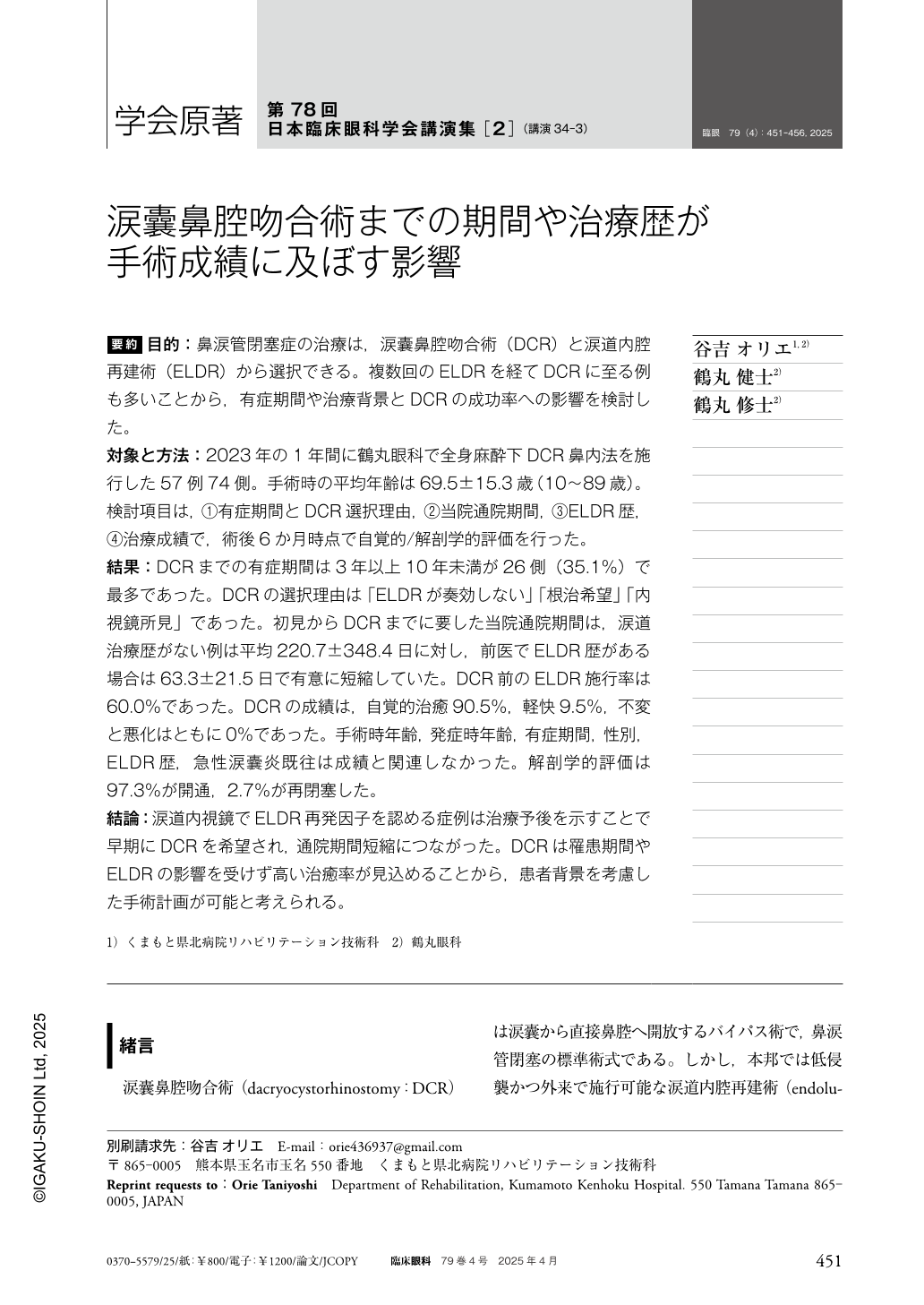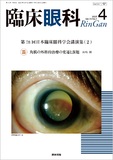Japanese
English
- 有料閲覧
- Abstract 文献概要
- 1ページ目 Look Inside
- 参考文献 Reference
要約 目的:鼻涙管閉塞症の治療は,涙囊鼻腔吻合術(DCR)と涙道内腔再建術(ELDR)から選択できる。複数回のELDRを経てDCRに至る例も多いことから,有症期間や治療背景とDCRの成功率への影響を検討した。
対象と方法:2023年の1年間に鶴丸眼科で全身麻酔下DCR鼻内法を施行した57例74側。手術時の平均年齢は69.5±15.3歳(10〜89歳)。検討項目は,①有症期間とDCR選択理由,②当院通院期間,③ELDR歴,④治療成績で,術後6か月時点で自覚的/解剖学的評価を行った。
結果:DCRまでの有症期間は3年以上10年未満が26側(35.1%)で最多であった。DCRの選択理由は「ELDRが奏効しない」「根治希望」「内視鏡所見」であった。初見からDCRまでに要した当院通院期間は,涙道治療歴がない例は平均220.7±348.4日に対し,前医でELDR歴がある場合は63.3±21.5日で有意に短縮していた。DCR前のELDR施行率は60.0%であった。DCRの成績は,自覚的治癒90.5%,軽快9.5%,不変と悪化はともに0%であった。手術時年齢,発症時年齢,有症期間,性別,ELDR歴,急性涙囊炎既往は成績と関連しなかった。解剖学的評価は97.3%が開通,2.7%が再閉塞した。
結論:涙道内視鏡でELDR再発因子を認める症例は治療予後を示すことで早期にDCRを希望され,通院期間短縮につながった。DCRは罹患期間やELDRの影響を受けず高い治癒率が見込めることから,患者背景を考慮した手術計画が可能と考えられる。
Abstract Purpose:Nasolacrimal duct obstruction can be treated using dacryocystorhinostomy(DCR)and endoluminal lacrimal duct recanalization(ELDR). Given the frequent need for DCR after multiple ELDR attempts, this study aimed to evaluate the effects of symptom duration, treatment history, and DCR success rates.
Patients and methods:This retrospective study evaluated 74 eyes from 57 men who underwent endoscopic DCR under general anesthesia at Tsurumaru Eye Clinic in 2023. The mean age at surgery was 69.5±15.3 years(10-89 years). The following parameters were examined:(1)duration of illness and the reason for selecting DCR,(2)duration of hospital visits,(3)ELDR history, and(4)treatment outcomes. Subjective/anatomical evaluation was performed at 6 months postoperatively.
Results:The duration of illness was>3 years but less than 10 years in 26 patients(35.1%). The primary reasons for selecting DCR were “ELDR failure,” “desire for a definitive cure,” and “endoscopic findings.” The average lengths of hospital visit prior to DCR were 220.7±348.4 days for patients who did not receive lacrimal canal treatment and 63.3±21.5 days for those with a history of ELDR. Prior to DCR, ELDR was performed in 60% of the study patients. Postoperatively, DCR achieved a 90.5% subjective cure rate, with 9.5% reporting improvement and 0% experiencing unchanged and worsened symptoms. Age at the time of surgery, age at onset, disease duration, sex, a history of ELDR, and a history of acute dacryocystitis were not associated with outcomes. Anatomical assessments were performed in 97.3% of patients who underwent lacrimal duct opening and 2.7% of those who underwent reocclusion.
Conclusion:Identifying recurrence factors through lacrimal endoscopy enabled the early selection of DCR and reduced the duration of hospital visits. As DCR outcomes are not influenced by disease duration or prior ELDR attempts and this procedure consistently yields high cure rates, it can be effectively planned based on the patient's clinical background.

Copyright © 2025, Igaku-Shoin Ltd. All rights reserved.


